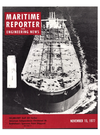
Page 7: of Maritime Reporter Magazine (November 15, 1977)
Read this page in Pdf, Flash or Html5 edition of November 15, 1977 Maritime Reporter Magazine
Here is an easy way to retrofit your crude oil tanker for Inert Gas Operation
In order to meet A.B.S. safety regulations, Inert Gas Systems on crude oil tankers require flue gas containing under 5% oxygen. But the problem facing ship owner/operators is that, without major and very costly modifications, most marine boilers simply can't produce such low-oxygen flue gas .. . particularly when operating under varying or low-power demand conditions.
But now, there's an efficient, economical way for you to retrofit for compliance with Inert Gas requirements. How? By installing a Gaulin Water-in-Fuel Emulsification System in your boiler room. Gaulin calls it an "F.E. System". And it will help you achieve:
Low-oxygen flue gas — you'll get safe, low-oxygen flue gas, even at low power levels, without the need to redesign your boiler front or windbox. Or to change burners. And without complex, sensitive control systems.
Much cleaner flue gas — the lowered oxygen level will combine with reduced particulate emissions to dramatically cut back the soot loading to your scrubber. Your scrubber maintenance costs will be slashed and the service life of your scrubber system will be greatly extended.
Improved combustion — Gaulin's F.E. System shipboard installations to date have provided a number of ship owner/operators with overall boiler efficiency improvement and significant fuel savings.
The F.E. System and how it works.
Gaulin's high-energy F.E. System utilizes a high-pressure homogenizer to break down the normally large ag- glomerates present in the fuel oil. A very small percentage of water is added and emulsified as part of the fuel mixture during the high-energy ho- mogenization process (much lower amounts of water concentration are used than with such methods as low- pressure ultrasonic or other light stirring or mixing techniques). The droplets of water become uniformly dispersed in the fuel and are essentially one-micron in size.
Micro-explosions achieved
After homogenization the Gaulin machine then delivers the completely emulsified water-in- fuel oil mixture to the boiler combustion chamber where the beneficial phe- nomenon known as "micro-explosions "occurs.The resulting secondary atomization produces an even better dispersion and mixing of the primary fuel spray.
The results? Reduced excess air... low-oxygen flue gas ... less soot loading to scrubbers and related piping ... improved boiler efficiency ... fuel savings.
A micro-graphic comparison of the burning of fuel droplets captured by sequential, high-speed, 16mm cinematography. The frames in the top sequence (5,000/sec.) resulted from burning a 350-micron droplet of water-in-Bunker C fuel oil emulsion. Those views in the lower series (4,000/sec.) record the combus- tion of a 450-micron droplet of neat Bunker C fuel. (Courtesy of Guggenheim Laboratories, Princeton
University)
AFTER
This before-and-after photomicrograph (1000X) graphically illustrates the superior effects achieved by Gaulin's F.E. System.
The control sample (left), a pre-mix of 6% water in #6 fuei oil, is dramatically com- pared with a sample of the homogenized fuel emulsion.
The Gaulin F.E. System — it can be retrofitted in your boiler system as a secondary fuel atomization process to help you economically produce low- oxygen, low-particulate flue gas from your boilers.
Learn the facts. * '3 *
Get the full technical story about the Gaulin F.E. System and how it can help you simplify your Inert Gas reirofit project. Contact Gaulin at Garden Street, Everett,
Mass. 02149. Telephone: (617) 387-9300, Telex: 094-9415.
November 15, 1977 9

 6
6

 8
8
